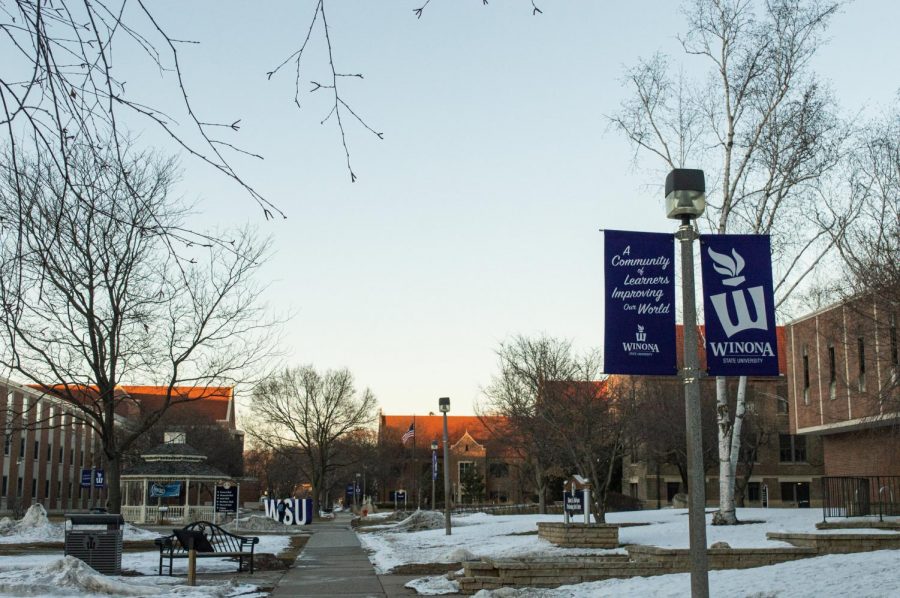Further COVID-19 relief funding likely for some WSU students
Federal CRRSAA money is currently being held by the Department of Education, which is requiring an official plan of disbursement to students before the withdrawing of funds. Following Senate’s recommendation, $284,847.80 would be allocated to the emergency fund, with $1,538,178.12 reserved for Pell grant and $1,025,452.08 for non-Pell grant students.
March 3, 2021
Student Senate voted on the Coronavirus Response and Relief Supplemental Appropriations Act (CRRSAA) disbursements to students on Feb. 23.
Senate voted for 60% of the funds to go towards Pell grant students, the grant named after the federal grant that assists students in financial need, and 40% to go towards non-Pell grant students, with 10% reserved for the backup emergency fund.
Senate’s recommendation will be sent to President Scott Olson’s office, who will then make a final recommendation to the chancellor of the Minnesota State system regarding payouts.
A total of $2,848,478 was allotted for students through CRRSAA.
Following Senate’s recommendation, $284,847.80 would be allocated to the emergency fund, with $1,538,178.12 reserved for Pell grant students and $1,025,452.08 for non-Pell grant students.
CRRSAA student aid relief will also include online students, a reversal from last spring’s Coronavirus Aid, Relief, and Economic Security (CARES) Act disbursement.
Scott Ellinghuysen, vice president of finance at Winona State, said some funds are still unclaimed by students from last spring’s CARES payments.
“We did have some students that did not have their bank account information set up or did not respond to our emails or text messages. We started with a large list of students that have not received their payments, but that number is very low now, around 40,” Ellinghuysen said.
Ellinghuysen said there is roughly less than $10,000 of CARES funds that will eventually be rolled over into the CRRSAA emergency fund if left unclaimed.
If students have unclaimed money from last spring’s CARES act, they can reach out to the Warrior Hub before funds are unavailable, Ellinghuysen said.
Some students however will be left out of the second round of aid payments, much like what happened with last spring’s CARES relief.
International and non-citizen students are currently excluded from CRRSAA relief payments, which is a continuation of federal policy from the CARES act.
Winona State has 135 international students enrolled.
Director of International Student and Scholar Services, Kit Klepinger, commented on the CRRSSAA payments.
Regarding the exclusion of international students from CRRSAA payments, Klepinger said, “Funds available through the CARES Act (and now CRRSAA) are not an option for many non-citizens, which includes international students in F-1 visa status. Disbursement of these funds has only been available to students who either filed a FAFSA or were eligible to file the FAFSA.”
However, the Associate Director of Financial Aid, Mari Livingston, said a previous law from 1996 was used to bar some students from receiving aid.
Livingston said the Personal Responsibility and Work Opportunity Reconciliation Act (PRWORA) was responsible for the ineligibility of international and non-citizen students to receive CRRSAA payouts.
“The Trump administration used PRWORA as reasoning for why certain students couldn’t receive funds. My national organization of financial aid administrators is asking the Biden administration to relook at the act and see if they feel the interpretation is the same,” Livingston said.
Advocacy efforts for this rule change involves groups such as the National Association of Foreign Student Advisors (NAFSA), whom Klepinger said is working on behalf of international and non-citizen students to reverse the Trump era decision that is attached to CRRSAA.
Livingston said international and non-citizen students would be included in the aid payouts if CRRSAA federal guidance was reversed from the Trump administrations PRWORA interpretation.
However, if guidance from the Department of Education and the Biden administration arrives too late, then non-eligible students will left out for a second time from federal aid, Livingston said.
Livingston said she expects CRRSAA payments to begin in a month after a final recommendation is made by the President’s office.
Federal CRRSAA money is currently being held by the Department of Education, which is requiring an official plan of disbursement to students before the withdrawing of funds, Livingston said.
Livingston added that once the money is withdrawn, the university has three days to use the funds.
Livingston also mentioned additional changes being made during the federal government’s second student aid payout.
During the CARES Act student distribution payments, use of the emergency fund was operated differently than it will under CRRSAA payouts, Livingston said.
Livingston said the university wants to, “look at the information students are providing us for a reason as to why they need the funds,” when awarding emergency fund applicants.
The CRRSAA emergency fund will also be available to a larger portion of students than previously was under the CARES Act.
“[The emergency fund offers] much more open communication to all students. [CARES funding] was targeted last time based on financial need, judged through FAFSA,” Livingston said.
Students will also have the option to apply CRRSAA emergency funds to outstanding university bills, such as tuition or housing, Livingston said.
Livingston said initial payouts will go directly into students accounts, while outstanding university bills can be paid for by the emergency fund and must be approved by the beneficiary of the funds.
Livingston hopes that in addition to the emergency fund, students that qualify will be able to utilize other government programs that can provide relief during the COVID-19 pandemic.
“Students that are very stressed out about money have a direct impact on education and we want to erase some of those barriers with the emergency funds,” Livingston said. “We want to encourage other programs as well, in addition to the emergency funds.”
Livingston said the Supplemental Nutrition Assistance Program (SNAP) can also help alleviate financial burden and immediate needs.
Livingston said the CRRSAA made changes to the existing SNAP.
“If food is an issue, then part of this act (CRRSAA) also provided changes to SNAP benefits and students could potentially get another $100 to $200 from this program,” Livingston said.
Livingston said she hopes the emergency fund and additional federal and state programs reach the most students possible, providing relief during a tumultuous time.



































